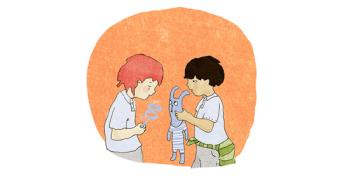
A landmark study of criminal activity in teenagers indicates that some never see crime as a course of action while others are vulnerable to environmental inducements to crime. The study reveals factors that explains why some young people are ‘crime-prone’ and others ‘crime-averse’, and explains why crime hot spots occur.
A landmark study of criminal activity in teenagers indicates that some never see crime as a course of action while others are vulnerable to environmental inducements to crime. The study reveals factors that explains why some young people are ‘crime-prone’ and others ‘crime-averse’, and explains why crime hot spots occur.
The idea that opportunity makes the thief - that young people will inevitably commit crime in certain environments - runs counter to our findings.
Per-Olof H Wikström
A unique study of teenagers and the community in Peterborough over ten years shows that most adolescent crime is not just youthful opportunism but the combined result of personal characteristics and environmental factors. The findings show that certain urban environments provide triggers for crime to which some teenagers are more vulnerable, while others remain highly resistant to the potential for crime – regardless of the circumstances.
The groundbreaking Peterborough Adolescent and Young Adult Development Study - or PADS+ - at Cambridge’s Institute of Criminology, tracked in detail the criminal activities of around 700 young people and explored how these relate to both their personal characteristics and social environments - while most studies of crime and its causes only focus on one or the other. The findings from the first 5 years of the study from ages 12-16 have been published in the book ‘Breaking Rules’ (Oxford University Press).
The young people self-reported about 16,000 crimes during the study period - dominant types being violence, vandalism and shoplifting. Crime is often publicly perceived to be a natural part of teenage life in the 21st century - but the findings show that a third of teenagers committed no crimes at all, and the vast majority of the rest only occasionally - one or two minor crimes a year on average.
The bulk of offences were committed by a small group - with around 4% responsible for almost half the crime and the overwhelming majority of the most serious property crimes - such as burglaries, robberies and car theft. Often beginning before the age of 12, the most persistent offenders in the study were also highly versatile in their criminality – committing a wide range of offences.
The study suggests that a major reason why certain young people refrain from crime is not because they fear the consequences; it’s that their morality simply prevents them from even seeing crime as a possible course of action in the first place.
The researchers found two main characteristics in teenagers resistant to committing crime - who they describe as ‘crime-averse’ - namely, a personal morality that closely matches the law and greater self-control. Those who committed little or no crime fit this model to a large extent.
Young people at the other end of the spectrum don’t care very much about breaking the rules of the law and tend to be impulsive and short-sighted, leaving them more vulnerable to the temptations of crime – they are ‘crime-prone’.
The 16% most ‘crime-prone’ young people committed 60% of the crimes, while the 16% most ‘crime-averse’ were only responsible for 0.5% of the crimes.
“Many young people are ‘crime-averse’ and simply don’t perceive crime as a possible course of action - it doesn’t matter what the situation is,” says Professor Per-Olof H Wikström, FBA, who leads the PADS+ research team. “The idea that opportunity makes the thief - that young people will inevitably commit crime in certain environments - runs counter to our findings. Rather, only the ‘crime-prone’ become vulnerable to said opportunities when taking part in environments with a moral context that encourages, or, at least, does not discourage, crime.”
The research included not just an in-depth longitudinal study of the lives and habits of 700 young people, but also a survey of over 6,000 local residents combined with large amounts of cross-referenced census and land use data to create a detailed impression of the environments in which the young people spend their time.
The findings show that crime is not only concentrated to a small group of young people, but also in certain times and places - known as ‘hot spots’. In many previous studies, crime hot spots have often been explained by the fact that they occur in areas where opportunities for crime are plentiful.
This new study goes much further, showing that crime hot spots are not only a consequence of opportunity but crucially the moral context - the level of enforcement of key common rules of conduct - in which these opportunities occur, and the presence of ‘crime-prone’ young people. Essentially, crime happens when ‘crime-prone’ people take part in moral contexts that encourage crime.
While some urban environments are largely free of youth crime, others include hot spots for young people’s crime. The study findings show that these crime hot spots occur in city and local centres, and residential areas that are characterised by poor informal social control resulting from weak social cohesion – known as poor collective efficacy. The findings also show that poor collective efficacy almost exclusively occurs in areas with a higher level of social disadvantage.
City and local centres and residential areas with poor collective efficacy have moral contexts in which ‘crime-prone’ young people are vulnerable to committing crime, particularly when they are engaged in unstructured and unsupervised activities.
The city and local centres provide many opportunities and frictions due to the presence of retail outlets and entertainment venues and also lack social cohesion among temporary visitors. Residents of areas which lack collective efficacy are less likely to intervene when young people engage in disorders and crime.
“In prevention we need to focus on developing policies that affect children and young people’s moral education and cognitive nurturing – which aids the development of greater self-control - and policies that help minimise the emergence of moral contexts conducive to crime” says Wikström. “In this context, one of the most important but least understood questions is the role of social disadvantage and how it affects the content and efficacy of young people’s moral education and cognitive nurturing.”
This work is licensed under a Creative Commons Licence. If you use this content on your site please link back to this page.





